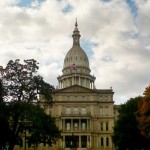
If it’s been a while since you familiarized yourself with state spending patterns and state school spending in particular, I suggest reviewing the State of Michigan House Fiscal Agency report embedded below along with one published by Gov. Snyder’s office, available here.
Here are my top ten observations prompted by my review of these two presentations, along with my previous years of analysis of state and local education budgets.
- The state has two primary funds; the General Fund (GF) and the School Aid Fund (SAF). The 2014-15 proposed General Fund totals $10.1 billion. Of that a mere $115,000 goes to the SAF. The SAF itself totals $12.3 billion – 20% higher than where state budget money goes to fund everything else but schools. Nearly 97% of the SAF goes to K-12 funding.
- Sales Taxes are the largest revenue source for the SAF – accounting for 46% of its total. Next highest source is Income Tax at 20%. Property Taxes, in the form of the State Education Tax, accounts for 15% of the SAF.
- SAF budget appropriations have increased every year since 2012, but the vast majority of those increases (almost all of it) has flowed to offset the underfunded Michigan Public School Employee Retirement System (MPSERS).
- In real dollars, Michigan’s SAF appropriations are down 7% from 2006 levels ($13.9 billion vs. $14.9 billion); however, student enrollment is down 11% in the same time (1.7 million to 1.51 million). So why have we struggled so much financially? One word – MPSERS.
- The proposed SAF budget is at its highest level since 2005. The controversy surrounding whether this is a true increase is based on such an increasing percentage flowing to MPSERS.
- MPSERS now accounts for 6.4% of the SAF budget and ever increasing portions of local school budgets. In 2014, 13.4% of the Grosse Pointe Public School System’s total General Fund budget was spent on MPSERS expense. Ten years ago it was about 8%. That’s about a $5.5 million increase in cost to fund legacy costs.
- From 2013 to 2018, the SAF is projected to grow by $2.2 billion – again reinforcing how Proposal A works well when the economy is stable and growing. But half of that revenue growth is earmarked to reduce MPSERS unfunded liability. In next year’s state budget alone, GP Schools would have been obligated for an additional $200 per student – or over $1.6 million – in MPSERS cost increase if the state did not defray that cost. This is a huge shift in how Michigan is better managing school budgets.
- The MPSERS reforms passes in 2012 have already reduced the unfunded liability from $47 billion to $31 billion.
- The proposed 2016 SAF budget with its $815 million allocation to pay down MPSERS liability translates to $600 per Michigan student. The 2012 reforms translates to $475 per student totaling $1,075 per each Michigan student. Without these reforms and investments, a district like Grosse Pointes’ would have seen $8 million in increased cost.
- Over the last couple of years, and into the next decade plus, local school districts will have been required to budget an incremental 25% of total salary costs to fund MPSERS. With all these reforms and pay-downs, that rate will decrease to less than 5% in 2039.
The summary, if I didn’t flog the dead horse above briskly and frequently enough, is similar to what I said so many times when I served on the Board of Education: MPSERS has been the beginning, middle and end of most of the economic trauma. It proved to be an unsustainable expense and the 2012 reforms and other Snyder administration budget and policy decisions are proving to address the root cause issue.